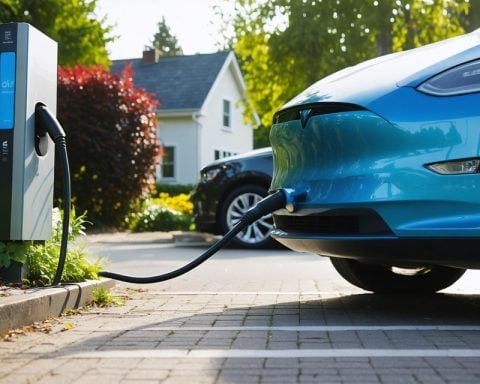- Winter conditions can severely impact electric vehicle battery performance, but new solutions are emerging.
- Chinese researchers are developing a lithium titanium phosphate (LTP) electrode material that improves battery efficiency in cold temperatures.
- LTP’s unique crystal structure includes cavities and channels that enhance lithium ion movement, even in sub-zero conditions.
- At 14°F, LTP-powered batteries maintain 84% ion mobility, providing significant cold-weather resilience.
- This technology has potential implications for electric vehicles and renewable energy storage, supporting global sustainability goals.
- Temperature-resistant batteries could lower costs and improve performance, making clean energy more accessible.
- Innovations like LTP align with environmental responsibility and federal incentives, paving the way for a more sustainable future.
Winter often poses an icy challenge for electric vehicle owners, as plummeting temperatures drain battery performance. In China, however, scientists have unveiled a promising solution that could keep drivers rolling through the chill without worry. Instead of shrinking away in the frost, a new electrode material defies expectation by expanding when the mercury drops.
Researchers from Shanghai’s Donghua and Fudan universities, along with Inner Mongolia University, are pioneering the use of lithium titanium phosphate (LTP) to improve battery efficiency in sub-zero conditions. Using advanced microscopy, the team discovered that LTP boasts a unique crystal architecture, peppered with cavities and channels. As temperatures decrease, these tiny spaces morph, facilitating the free movement of lithium ions—a crucial factor in maintaining battery cycles.
At a brisk 14 degrees Fahrenheit, LTP-powered cells retained an impressive 84% of their ion mobility compared to warmer conditions. This cold-weather resilience could propel everything from electric vehicles to renewable energy storage to new heights, a critical advance as the globe races toward sustainable power solutions.
In a world increasingly ravaged by severe weather, reliable energy storage becomes more essential. As nations scale up renewables like solar and wind, they face the challenge of storing that energy to ensure consistent supply. Here, temperature-resistant batteries could play a pivotal role, not just by improving performance but by de-escalating costs, making clean energy more accessible.
With federal incentives on the line, advancements such as the frigid-friendly LTP offer a beacon of hope. They usher in a future where innovation aligns with environmental responsibility, making it possible for us to embrace both a cleaner and more efficient tomorrow.
Revolutionary Battery Breakthrough: How LTP Technology Can Power the Future
How-To Steps & Life Hacks
Improving the cold-weather performance of electric vehicle (EV) batteries using lithium titanium phosphate (LTP) technology can transform the way owners approach winter driving. Here’s how:
1. Pre-Condition Your Battery: Before driving, ensure your EV battery is warm. This can be done by charging it in a warmed environment or using pre-conditioning features available in some EVs.
2. Optimize Charging Habits: Charge your vehicle in short bursts to keep the battery at an optimal temperature during extreme cold.
3. Use Insulation: If you live in a cold climate, consider adding an insulating layer to your battery compartment to combat the cold effects.
4. Regular Maintenance: Regularly check your battery’s health. Cold temperatures can exacerbate underlying battery issues.
Real-World Use Cases
The unique properties of LTP could significantly benefit several sectors:
– Electric Vehicles: Enhanced cold-weather performance will lead to increased adoption of EVs in regions with harsh winters.
– Renewable Energy Storage: With more reliable batteries, solar and wind energy can be stored more efficiently, aiding in grid stability and energy distribution.
– Portable Electronics: Consumer gadgets will experience longer usage times in cold environments, from smartphones to laptops.
Market Forecasts & Industry Trends
As the race toward sustainable energy gains momentum, the demand for improved battery technologies is soaring. By 2030, the global battery market is expected to reach over $120 billion, driven largely by electric vehicles and renewable energy storage solutions (Source: MarketsandMarkets).
The improvement of cold-weather battery performance is anticipated to be a significant trend, putting LTP technology in a favorable market position.
Reviews & Comparisons
When compared to traditional lithium-ion batteries, LTP stands out due to its cold-weather resilience. While lithium-ion batteries can lose up to 40% of their capacity in extreme cold, LTP retains up to 84% of its ion mobility. However, LTP may not yet match the energy density of existing solutions, necessitating further research for commercial adoption.
Controversies & Limitations
Despite its promising attributes, LTP technology must overcome several challenges:
– High Production Costs: The manufacturing of LTP is currently more expensive than traditional materials.
– Energy Density: LTP batteries may have a lower energy density, affecting their overall capacity.
Features, Specs & Pricing
– Ion Mobility: Retains 84% at 14°F
– Crystal Structure: Unique architecture with cavities and channels
– Cost: Higher than lithium-ion due to manufacturing complexities
Security & Sustainability
LTP technology aligns with sustainability goals by promising an extended battery life, which reduces waste and resource consumption. Additionally, its operation at lower temperatures enhances operational security in more extreme environments.
Insights & Predictions
Experts predict that LTP will not only revolutionize EV performance in cold climates but also catalyze an industry-wide shift toward more resilient energy storage solutions. Investments in LTP research are expected to grow exponentially, further integrating this innovation into mainstream applications.
Pros & Cons Overview
Pros:
– Excellent low-temperature performance
– Potential to reduce reliance on fossil fuels
– Aids in renewable energy integration
Cons:
– Higher manufacturing costs
– Lower energy density currently
Conclusion and Recommendations
For consumers and industries eager to leverage LTP technology, the following actionable tips may help:
– Stay Informed: Watch for new product releases integrating LTP technology to maximize investment value.
– Policy Advocacy: Encourage policymakers to support LTP research and subsidize its commercial adoption.
By embracing these emerging technologies, we can move closer to achieving global sustainability goals.
For further information on battery technologies and advancements, visit Energy.gov.













